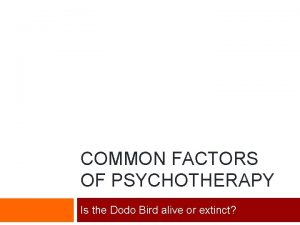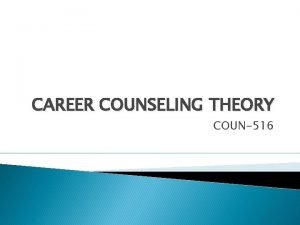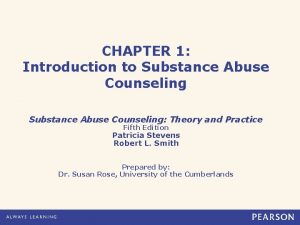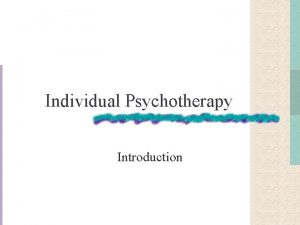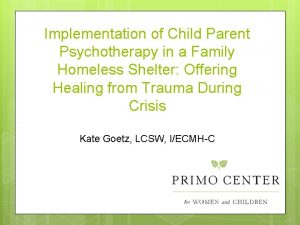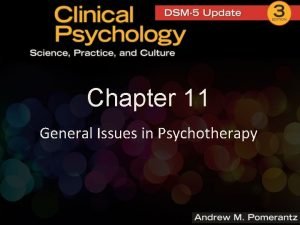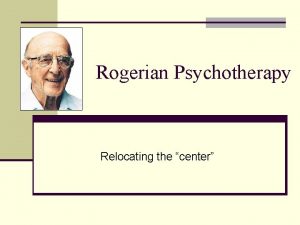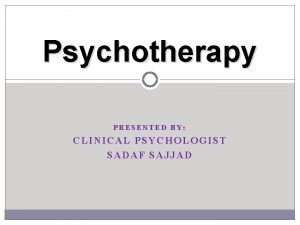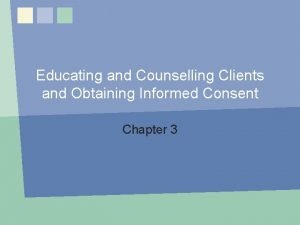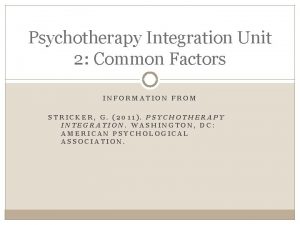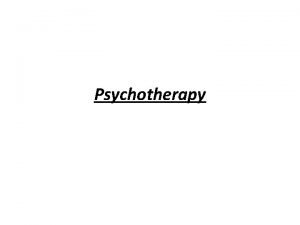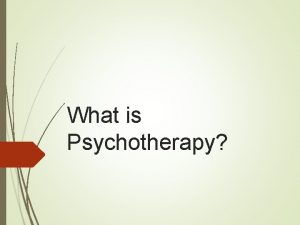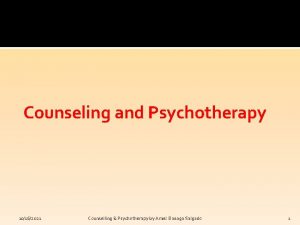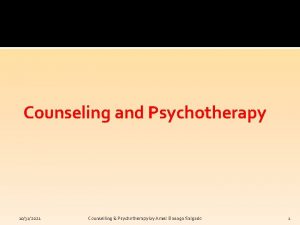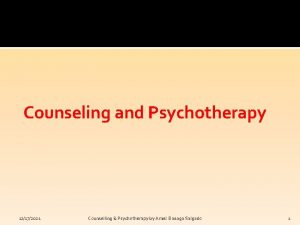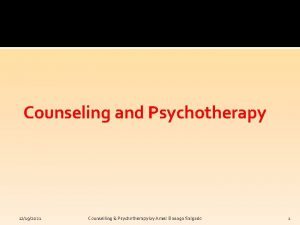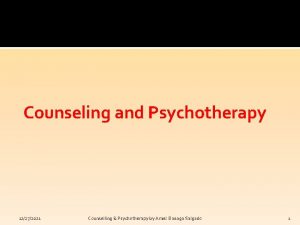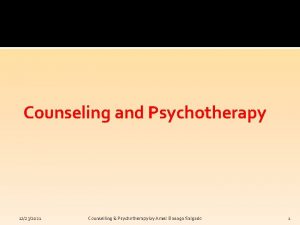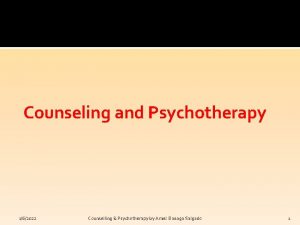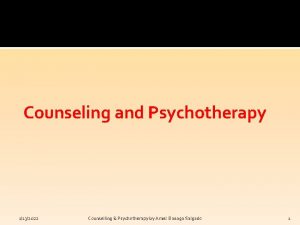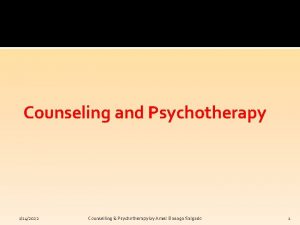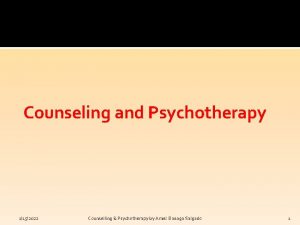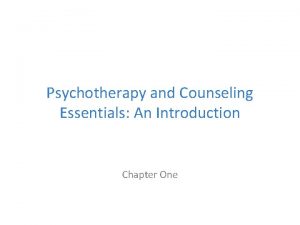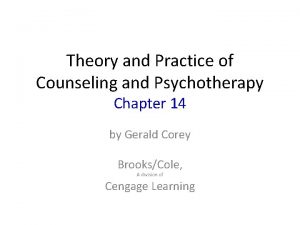Chapter One Introduction to Psychotherapy and Counseling Theory



















- Slides: 19

Chapter One: Introduction to Psychotherapy and Counseling Theory and Technique

Background and Overview ¨ Opening stories – First client – Second client – 22 years later ¨ Determining why people suffer, how they change, and how to help them live more satisfying and gratifying lives is a huge task.

Historical Context ¨ The Father of Psychotherapy? ¨ Alternative Historical-Cultural Realities: Three Perspectives – The biomedical perspective – The religious/spiritual perspective – The psychosocial perspective

Definitions of Counseling and Psychotherapy ¨ What is Psychotherapy? ¨ What is Counseling? ¨ What are the Differences between Psychotherapy and Counseling? ¨ A Working Definition of Counseling and Psychotherapy: “A trained person who practices the artful application of scientifically derived principles. . . (see p. 9).

What is a Theory? ¨ “A coherent group of general propositions used as principles of explanation for a class of phenomena” (Random House, 1993, p. 1967). ¨ For counseling and psychotherapy, a theory needs to accurately describe, explain, and predict a wide range of therapist and client behaviors (p. 9).

Modern Therapy: Does it work? ¨ Eysenck’s early review ¨ A celebration of effectiveness ¨ Is psychotherapy harmful? ¨ Are psychotherapy researchers and practitioners objective?

What Helps Clients: Common Factors or Specific Techniques? ¨ Specific techniques ¨ Common therapeutic factors – Extratherapeutic change (40%) – Therapeutic relationship (30%) – Expectancy (15%) – Techniques (15%) ¨ Techniques or common factors? The wrong question

Ethical Essentials ¨ Confidentiality ¨ Multiple roles ¨ Client harm: The sexual abuse of therapy clients ¨ Competence and informed consent ¨ Additional ethical issues

Emergence of Personal Theory ¨ Your first client and your first theory ¨ Your emerging personal theory (see Practitioner Commentary, 1. 1) ¨ A summary of 12 major theoretical perspectives (see Table 1. 1)

Our Biases ¨ Our theoretical roots ¨ Balance and uncertainty ¨ Theory versus technique

The Zeitgeist, the Ortgeist, and the Poltergeist ¨ Zeitgeist: The spirit of the time ¨ Ortgeist: The spirit of the place ¨ Poltergeist: A mischievous spirit or ghost ¨ Experience your theory (see Practitioner Commentary 1. 2)

Concluding Comments ¨ You’ve just been on a quick tour of some major issues in counseling and psychotherapy. ¨ We wish you the best as you explore the main theories of therapy in greater depth.

Student Review Assignments ¨ Critical corner ¨ Reviewing key terms ¨ Review questions

Critical Corner ¨ 1. Most of the psychological theories reviewed in this book were developed by privileged, White, and European or American males. Given the narrow origins of these theories, how can the information provided be useful to you as a developing mental health professional?

Critical Corner (continued) ¨ 2. Smith, Glass, and Miller in their extended meta -analysis of therapy outcome studies concluded that the average person treated in therapy was better off than 80% of the untreated sample. Of course, they neglected to comment on the inverse fact that average untreated person was better off than about 20% of the treated clients. What does this inverse statement suggest? Are there large numbers of treated therapy clients who are getting worse? Or are some untreated clients somehow spontaneously getting better?

Critical Corner (continued) ¨ 3. In this chapter we’ve suggested that you begin to explore different theories and that, in the end, perhaps the best theory will be your personal theory. Is this a valid suggestion? Might you be better off to simply adopt a particular theory and hang in there with it, despite its limitations? Wouldn’t you be better off just knowing one theory very well, rather than knowing a little bit about many different perspectives?

Reviewing Key Terms Ø The biomedical perspective Ø The religious/spiritual perspective Ø The psychosocial perspective Ø Trephining Ø Meta-analysis Ø The Do Do bird effect Ø Extratherapeutic change Ø Confidentiality

Key Terms (continued) Ø Informed consent Ø Zeitgeist Ø Ortgeist Ø Poltergeist

Review Questions ¨ 1. What is the difference between a therapeutic experience and a therapy experience? ¨ 2. Who was Hans Eysenck? Why is he important to the evolution of psychotherapy and counseling? ¨ 3. What are the common factors and their relative importance as described by Lambert (1992)? ¨ 4. Why is sexual contact between therapist and client now referred to as sexual abuse of clients? ¨ 5. What are the limits of confidentiality in therapy?
 What are the differences between guidance and counselling
What are the differences between guidance and counselling Cognitive psychology ppt
Cognitive psychology ppt Dodo bird conjecture
Dodo bird conjecture Counselling psychology
Counselling psychology Night structure
Night structure Frank parsons trait and factor theory pdf
Frank parsons trait and factor theory pdf Substance abuse counseling theory and practice
Substance abuse counseling theory and practice Andrew pethebridge
Andrew pethebridge Psychotherapy ap psychology definition
Psychotherapy ap psychology definition Types of individual psychotherapy
Types of individual psychotherapy Cpp triangle of explanation
Cpp triangle of explanation Bracketing therapy
Bracketing therapy General issues in psychotherapy
General issues in psychotherapy Who is carl rogers
Who is carl rogers Psychotherapy refers to
Psychotherapy refers to Sajjad urban dictionary
Sajjad urban dictionary Individual psychotherapy definition
Individual psychotherapy definition Quantum psychotherapy
Quantum psychotherapy The primary goal of cognitive psychotherapy is
The primary goal of cognitive psychotherapy is Common factors approach psychotherapy integration
Common factors approach psychotherapy integration


